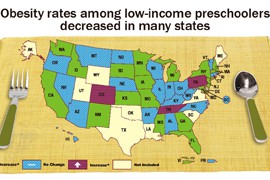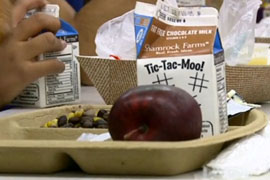Cronkite News has moved to a new home at cronkitenews.azpbs.org. Use this site to search archives from 2011 to May 2015. You can search the new site for current stories.
Study: Childhood obesity in Arizona levels off, as national rate falls
WASHINGTON – The obesity rate for low-income Arizona preschoolers remained level from 2008 to 2011 after growing sharply in previous years, according to a new Centers for Disease Control and Prevention study.
While 18 states saw decreases in their childhood obesity rates over that period, experts in Arizona welcomed the leveling-off in the state’s rate as a step in the right direction. Arizona was one of 19 states with no change in their childhood obesity rates.
“It has taken us a long time to get to this point,” said Ashleigh May, a CDC epidemiologist and author of the study. “We hope we are turning the tide.”
Vince Kame, founder and president of WiL Power Challenge, welcomed the findings but agreed with May that more work needs to be done.
“I think it’s a great start, but it’s way too early to rest on any of those laurels,” Kame said. “I really hope that people don’t take a little bit of good news like this and breathe a sigh of relief, because we still need that massive shift of thought that this is a huge, huge national problem.”
The CDC study looked at obesity among children between ages 2 and 4 in 43 states and U.S. territories. Ten states were not included in the report because of inconsistent data, the CDC said.
The study found that the childhood obesity rate in Arizona was 14.5 percent in 2011, just above the national average of 14.4 percent that year.
Only three states, Colorado, Pennsylvania and Tennessee, had increases in child obesity from 2008 to 2011, the period studied in the report.
It marked a reversal from previous reports for Arizona, which saw obesity of low-income preschoolers skyrocket from 9.7 percent in 1998 to 14.6 percent by 2008.
Kame, whose nonprofit offers fitness and nutritional guidance, said the leveling off could have partly to do with how high the rate is: “It almost had to stabilize because there was almost nowhere else to go. Even though this is very, very good news, it still could be better.”
Adrienne Udarbe, a registered dietician and community programs manager at the Arizona Department of Health, agreed that no growth in Arizona’s obesity rate is “a step in the right direction.”
Experts said it is hard to pinpoint the causes of the slow-down or drops in obesity, but May pointed to three factors.
She cited federal programs, like first lady Michelle Obama’s “Let’s Move!” campaign, a change in dietary guidelines for Women, Infant, and Children programs across the country, and an increase in breast-feeding.
Udarbe also pointed to the state health department’s Empower program, which promotes healthy eating, physical activity and breast-feeding. She said the program has reached more than 200,000 Arizona children since it was created in 2009.
But Kame said that while he has seen an increase in obesity awareness in recent years, he has not always seen that awareness translated into action.
“I haven’t really seen a big increase in what people do with that awareness,” he said. “Everybody agrees that it’s a problem but very few people are actually acting on it.”
Experts said the next report on the state of obesity will be telling.
Melanie Hingle, assistant professor of nutritional sciences at the University of Arizona, said that both Congress and parents have a responsibility to continue efforts to curb obesity.
“Parents need to lead the way, and Congress needs to continue funding” programs, Hingle said. “Less funding means less money to work with.”
Udarbe said that in order for Arizona’s obesity rates to drop, teamwork at all levels will be necessary.
“The weight of the world can’t fit on one person’s shoulders,” Udarbe said.








